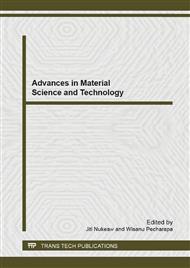p.159
p.164
p.169
p.174
p.179
p.184
p.189
p.194
p.199
Microstructure and Hardness of Cu-Zn-Si-Al-Sn Brasses with Antimony Addition
Abstract:
The objective of this work is to study the effect of antimony on as-cast microstructures and hardness of dual phase brassed. The studied compositions consisted of 56Cu-(42-X)Zn-1Si-0.5Al-0.5Sn-(X)Sb with varied antimony content in the range of 0.5-2.0 wt%. The alloys were prepared by melting pure elements using an induction furnace in graphite crucible at the temperature about 1,200 °C. The chemical composition of each alloy has been analyzed by X-ray fluorescence (XRF). Microstructures of the as-cast ingots were investigated by optical microscopy and scanning electron microscopy including the chemical analysis of the phase determined by X-ray energy dispersive spectroscopy (EDS). The obtained results suggested that the microstructures of as-cast ingots exhibited the beta-gamma dual phases. The beta phase was the matrix and the gamma phase extended along the grain boundary. The increase in antimony content increased the gamma phase and enhanced the hardness. Moreover, the antimony addition 2 wt% created the intermetallic compound (IMC) phase like a needle shape. The EDS analysis of IMC displayed 12.35 wt% antimony.
Info:
Periodical:
Pages:
179-183
Citation:
Online since:
September 2013
Keywords:
Price:
Сopyright:
© 2013 Trans Tech Publications Ltd. All Rights Reserved
Share:
Citation:


